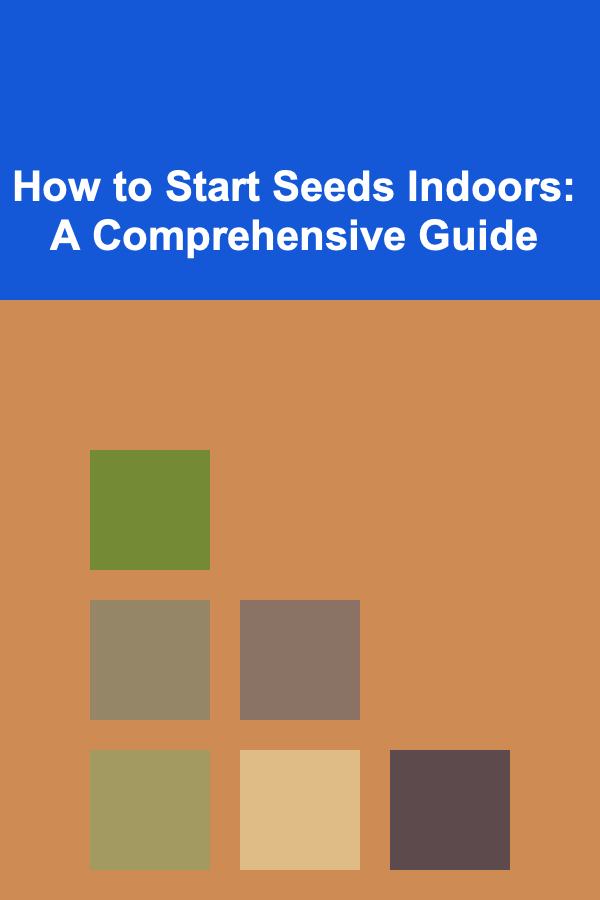
How to Start Seeds Indoors: A Comprehensive Guide
ebook include PDF & Audio bundle (Micro Guide)
$12.99$9.99
Limited Time Offer! Order within the next:

Starting seeds indoors is a popular gardening technique that allows you to get a head start on your growing season. By starting seeds inside, gardeners can ensure they have healthy, strong plants ready for transplanting outdoors once the weather warms up. Whether you are a seasoned gardener or a complete beginner, starting seeds indoors can be a rewarding experience. This guide will cover everything you need to know, from choosing seeds to transplanting your seedlings into your garden.
Why Start Seeds Indoors?
Starting seeds indoors provides several advantages for gardeners. These include:
1. Extended Growing Season
By starting seeds indoors, you can get a head start on your growing season. Plants such as tomatoes, peppers, and certain herbs take a long time to mature. Starting them indoors allows them to establish strong roots and begin growing before being transplanted outdoors when the weather is more favorable.
2. Better Control Over Growing Conditions
Indoor environments give you more control over temperature, humidity, and light. This is especially useful for plants that require specific conditions to germinate and thrive, like tropical plants or vegetables with longer growing periods.
3. Cost-Effective
Starting plants from seeds indoors can be far more cost-effective than purchasing established plants from a nursery. You can grow many plants from just one packet of seeds and save money over time.
4. Variety of Plant Options
When you start seeds indoors, you open up the possibility of growing a wider variety of plants, including those that may not be easily available in local nurseries. Many heirloom and rare varieties can be started from seed indoors, giving you more diversity in your garden.
The Basics of Seed Starting Indoors
Before you get started, it's essential to understand a few basic concepts related to seed starting. Here's what you need to know:
1. When to Start Seeds Indoors
The timing for starting seeds indoors depends on your region's last frost date and the plant species. To determine the best time, count backward from your region's last frost date (typically in spring) by the number of weeks required for the seeds to mature and harden off before being planted outside.
For instance, if your region's last frost date is May 15, and you are planting tomatoes that require an 8-week growing period indoors, you would start your seeds indoors around March 20.
2. Choosing the Right Seeds
Not all plants should be started indoors. Some plants, like beans, cucumbers, and squash, grow quickly and don't benefit from indoor sowing. Others, like tomatoes, peppers, and brassicas (broccoli, cabbage), benefit significantly from being started indoors.
When selecting seeds for indoor planting, look for varieties that are specifically labeled as suitable for starting indoors. These are often plants that require a long growing period or need specific temperature and light conditions to thrive.
3. Choosing Containers and Equipment
Starting seeds indoors requires the right containers and equipment to give your seedlings the best possible environment to grow. Here's a breakdown of what you need:
- Seed Starting Trays: You can use specialized seed starting trays, which typically have individual cells for each seed. Alternatively, you can use any container with drainage holes, like plastic cups or yogurt containers.
- Growing Medium: Choose a high-quality seed starting mix, which is typically lighter and more sterile than regular garden soil. This ensures proper drainage and minimizes the risk of disease.
- Lights: Since natural sunlight may not be strong enough indoors, invest in grow lights. Fluorescent lights or LED grow lights are the best options for providing your seeds with the light they need to thrive.
- Heating Mat: Some seeds require warmth to germinate. Using a seed-starting heat mat can help regulate the temperature of the growing medium and encourage faster germination.
- Watering Tools: A spray bottle or gentle watering can will help you keep the soil consistently moist without over-saturating it.
4. Germination Process
The germination process involves the seed sprouting and developing into a seedling. Different seeds have different requirements for germination, but the general steps are as follows:
- Moistening the Soil: Lightly moisten the seed-starting mix before planting the seeds. The soil should be damp, not soaking wet.
- Planting the Seeds: Follow the seed packet instructions for depth and spacing. Generally, plant seeds at a depth of about 2-3 times the size of the seed.
- Maintaining Ideal Temperature: Keep your seeds in a warm location, typically between 65°F (18°C) and 75°F (24°C). You can use a heat mat to regulate the temperature if necessary.
- Providing Light: Once the seeds sprout, they need 12-16 hours of light per day. If you are using grow lights, keep the lights 2-3 inches above the seedlings to prevent them from becoming leggy.
- Watering: Keep the soil moist but not waterlogged. Water gently, either with a spray bottle or a watering can with a fine spout. Avoid splashing water directly on the seeds, as this can cause them to shift position.
5. Transplanting Seedlings Outdoors
Once your seedlings have grown large enough and the outdoor conditions are suitable, it's time to transplant them into your garden or larger containers. Here's how to do it:
- Harden Off Seedlings: Before transplanting, gradually acclimate your seedlings to outdoor conditions by hardening them off. This involves taking them outside for a few hours each day and slowly increasing the time spent outdoors over 7-10 days. This process helps them adjust to the sun, wind, and temperature changes.
- Prepare the Garden Bed: Ensure your garden bed is well-prepared, with loose, fertile soil. If necessary, amend the soil with compost or organic matter to improve drainage and nutrition.
- Transplant Carefully: When transplanting, handle the seedlings gently by their leaves, not their stems, to avoid damage. Dig a hole slightly larger than the root ball, place the seedling in, and cover the roots with soil. Water the seedlings immediately after planting.
Tips for Success
1. Keep the Environment Consistent
Consistency is key when starting seeds indoors. Keep the temperature, humidity, and light levels as stable as possible to give your seeds the best chance of thriving. Avoid placing seedlings in drafty areas or near heat sources, as this can cause temperature fluctuations that may stunt growth.
2. Thin Seedlings as Needed
Once your seedlings have developed several sets of leaves, thin them out to prevent overcrowding. If you've planted multiple seeds in a single container or cell, cut away the weaker seedlings to give the remaining ones room to grow.
3. Fertilize Sparingly
Seedlings generally don't need a lot of fertilizer, especially in the early stages. Once the seedlings have their first true leaves, you can start fertilizing with a diluted, balanced fertilizer. Be sure not to over-fertilize, as this can lead to leggy, weak plants.
4. Watch for Pests
While starting seeds indoors reduces the chances of pests, they can still be an issue. Keep an eye on your seedlings for any signs of pests, such as tiny holes in the leaves or sticky residue. If you spot pests, address the issue immediately using organic methods like insecticidal soap or neem oil.
5. Maintain Humidity
Newly germinated seeds need a higher level of humidity to thrive. Consider using a humidity dome or a plastic cover over your seed trays to keep moisture levels up. Once the seedlings start to grow, you can remove the cover to allow for better air circulation.
Common Problems and Solutions
1. Leggy Seedlings
If your seedlings are growing tall and spindly, it's usually a sign that they're not getting enough light. Adjust your grow lights to be closer to the seedlings, or consider using stronger lights to promote healthier growth.
2. Overwatered Seedlings
Overwatering is a common mistake when starting seeds. To avoid this, make sure your containers have proper drainage and only water when the soil is dry to the touch. Always water gently to avoid disturbing the seeds or seedlings.
3. Slow or Uneven Germination
If your seeds aren't germinating as expected, check the temperature and moisture levels. Some seeds require specific conditions to germinate, so always refer to the seed packet for precise instructions. If necessary, adjust your growing conditions or use a seed-starting heat mat to boost germination.
Conclusion
Starting seeds indoors is a rewarding and cost-effective way to grow plants, whether for your vegetable garden or flower beds. With careful planning, the right equipment, and a little attention, you can successfully start seeds indoors and enjoy healthy, robust plants ready for transplanting. Remember to be patient, monitor your seedlings closely, and adapt as needed. With practice, you'll become more confident in your seed-starting abilities, and your garden will thrive as a result.

How to Automate Your Finances for Better Control
Read More
How to Improve Home Security When You Live in an Apartment
Read More
How to Organize a Joint Budget with Your Partner
Read More
How to Create a Successful Online Presence for Your Small Business
Read More
How to Start a Food Truck Business: A Comprehensive Guide
Read More
How to Differentiate Between a Psychiatrist and Other Mental Health Professionals
Read MoreOther Products

How to Automate Your Finances for Better Control
Read More
How to Improve Home Security When You Live in an Apartment
Read More
How to Organize a Joint Budget with Your Partner
Read More
How to Create a Successful Online Presence for Your Small Business
Read More
How to Start a Food Truck Business: A Comprehensive Guide
Read More